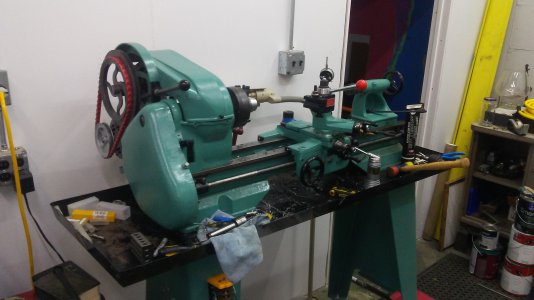Hi all. I'm a total newbie but I finally got my lathe up and running after a full restoration. I finally had the money to get a new Shars 6" 3 Jaw chuck with a backing plate for it. The chuck advertises 0.003" TIR. I turned down the backing plate as it was threaded on the spindle and verified with my indicator that it runs completely true on both the face and on the edge of the registration. After bolting the chuck to the backing plate, I can verify the face of the chuck runs true but I've got 0.014" run out with a piece of 3/4" O1 stock chucked up.
I tried unbolting the chuck and rotating it around the backing plate to all three mounting positions. Each mounting position has the same 0.014" run out. I tried loosening the bolts and tapping the chuck with a rubber mallet but the run out is still 0.011".
Would it be acceptable to turn 0.005" off the registration on the backing plate and then place a suitable shim on one side (or multiple places)? Would this correct the run out and actually be a workable, long term solution? Or would I just ruin the backing plate. I don't have the capabilities to grind the jaws but I would like to get this chuck to be at the 0.003" TIR as advertised without having to deal with an attempt at returning the chuck and having Shars tell me that I didn't turn the backing plate to the correct dimensions and refuse to fix the issue.
Included for your enjoyment: 1944/5 Craftsman Lathe powder coated in mint turquoise with black accents. As a side note, the lathe was given to me by my old neighbor when he went out of business. Hadn't been used in probably 25 years and was rusty as could be. It has/had a few parts missing so I'm trying to get it tooled up and in as good as working condition as I can get it.

Thanks in advance for your help with ideas on how to get the chuck to be more concentric.
I tried unbolting the chuck and rotating it around the backing plate to all three mounting positions. Each mounting position has the same 0.014" run out. I tried loosening the bolts and tapping the chuck with a rubber mallet but the run out is still 0.011".
Would it be acceptable to turn 0.005" off the registration on the backing plate and then place a suitable shim on one side (or multiple places)? Would this correct the run out and actually be a workable, long term solution? Or would I just ruin the backing plate. I don't have the capabilities to grind the jaws but I would like to get this chuck to be at the 0.003" TIR as advertised without having to deal with an attempt at returning the chuck and having Shars tell me that I didn't turn the backing plate to the correct dimensions and refuse to fix the issue.
Included for your enjoyment: 1944/5 Craftsman Lathe powder coated in mint turquoise with black accents. As a side note, the lathe was given to me by my old neighbor when he went out of business. Hadn't been used in probably 25 years and was rusty as could be. It has/had a few parts missing so I'm trying to get it tooled up and in as good as working condition as I can get it.

Thanks in advance for your help with ideas on how to get the chuck to be more concentric.
